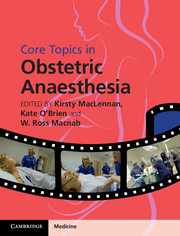Book contents
- Frontmatter
- Contents
- List of contributors
- Preface
- Section 1 Basic science, epidemiology and service organization
- 1 Physiology of pregnancy
- 2 Placental physiology
- 3 Pharmacology relevant to pregnancy
- 4 Maternal morbidity and mortality
- Section 2 Obstetric aspects
- Section 3 Provision of anaesthesia
- Section 4 Medical conditions in pregnancy
- Section 5 Postpartum complications and obstetric emergencies
- Section 6 Service organization
- Index
- Plate section
- References
2 - Placental physiology
from Section 1 - Basic science, epidemiology and service organization
Published online by Cambridge University Press: 05 December 2015
- Frontmatter
- Contents
- List of contributors
- Preface
- Section 1 Basic science, epidemiology and service organization
- 1 Physiology of pregnancy
- 2 Placental physiology
- 3 Pharmacology relevant to pregnancy
- 4 Maternal morbidity and mortality
- Section 2 Obstetric aspects
- Section 3 Provision of anaesthesia
- Section 4 Medical conditions in pregnancy
- Section 5 Postpartum complications and obstetric emergencies
- Section 6 Service organization
- Index
- Plate section
- References
Summary
Introduction
The placenta is an organ that connects a developing fetus to the uterine wall for exchange of oxygen, nutrients, antibodies and hormones between the mother and fetus. It is required for the removal of waste products. The development of the placenta is essential for normal fetal growth, development, and the maintenance of a healthy pregnancy.
Embryological development
The placenta begins to develop upon implantation of a blastocyst into the maternal endometrium, leading to rapid proliferation and differentiation of trophoblasts. This leads to the formation of two layers: the cytotrophoblast and syncytiotrophoblast. As the blastocyst implants in the uterine lining, vacuoles and lacunae form within the syncytiotrophoblast. This network of lacunae eventually become the intervillous spaces. The cytotrophoblast erodes deeper into the endometrial tissues leading to formation of chorionic villi, which will cover the entire surface of the chorionic sac. Transformation of the narrow spiral arteries into wide uteroplacental arteries also takes place, due to invasion of cytotrophoblasts into the vascular smooth muscle and endothelial cells. The maternal endometrium undergoes various changes, known collectively as the decidual reaction, forming the decidua, which is shed at delivery.
Anatomical structure
The placenta is discoid in shape with a diameter of 15 to 25 cm. A full-term placenta is approximately 2–3 cm thick and weighs about 500–600 g. The growth of the placenta roughly parallels that of the expanding uterus and covers approximately 15 to 30% of the internal surface of the uterus. It consists of two components: a fetal and a maternal portion.
The fetal component of the placenta is formed by the wall of the chorion (chorionic plate). The villi that arise from it project into the intervillous spaces which contain maternal blood. The maternal component of the placenta, on the other hand, is formed by the decidua basalis, which is the endometrium, deep into the fetal component of the placenta. The two components are held together by the cytotrophoblastic shell. Wedge-shaped areas of decidual tissues, known as placental septa, form as the villi invade the decidua, leading to grooves when viewed from the maternal side of the placenta. Cotyledons are easily recognizable bulging areas that are covered by a thin layer of decidua basalis.
- Type
- Chapter
- Information
- Core Topics in Obstetric Anaesthesia , pp. 9 - 12Publisher: Cambridge University PressPrint publication year: 2015



